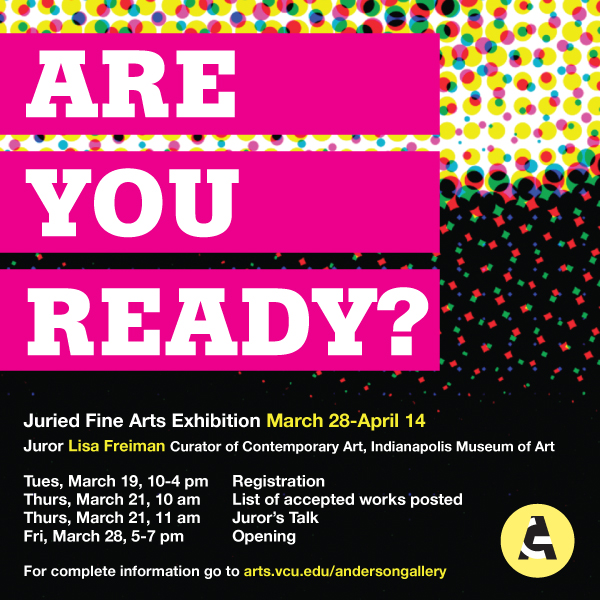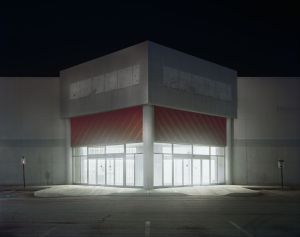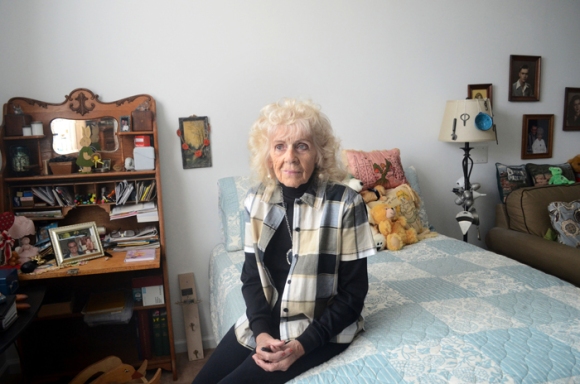The fall season brings an array of exhibitions to the Anderson Gallery representing diverse approaches to material, form, and content. Visitors will encounter works on paper by the groundbreaking artist and anti-war activist Nancy Spero, and new works by two VCUarts faculty members—Bohyun Yoon, a newly appointed professor in the glass program of the Craft/Material Studies Department, and Hilary Wilder, an associate professor in the Painting + Printmaking Department. The Gallery will also screen an international selection of videos by 35 artists that reinforces the far-reaching importance of this medium around the globe.
All exhibitions will open on Friday evening, September 6, from 5-7 pm, with a free public reception. They continue through December 8.

Nancy Spero
The Underworld, 1997
Handprinting and printed collage on paper
63 x 19 inches (160 x 48.3 cm)
© Estate of Nancy Spero. Licensed by VAGA, New York. Courtesy Galerie Lelong, New York
One of the first opportunities in the U.S. to revisit Spero’s work since her death in 2009, this exhibition features two dozen rarely seen collages from the 1980s and 90s. These works reveal the artist’s innovative approach to printmaking in scroll-like expanses of paper, as well as her lifelong engagement with contemporary political, social, and cultural issues.
Spero decided to make women the sole subject of her artwork from 1976 onwards, drawing from different cultures, histories, and mythologies to create a heterodox pantheon of female archetypes. During the period addressed here, she continued to pay special attention to women as victims of war, furthering the investigation she began so powerfully in her War Series (1966-1970). In one group of works, she unflinchingly probes the torments resulting from oppressive regimes in Argentina, Nicaragua, El Salvador, and South Africa. Spero’s work from the 1990s, however, acquires a greater sense of agency and optimism as she removed her figures from historical contexts of suffering and subordination, transforming them into resilient, celebratory protagonists through color, rhythm, and humor.
Special thanks to Mary Sabbatino and the staff of Galerie Lelong for their generous assistance.
Bohyun Yoon: Neighbors
Bohyun Yoon uses the special properties of glass and the play of light and shadow to create installation, sound, and video works that often incorporate performance and the body. His fascination with cultural diversity, sparked by his 2001 move to the US from Korea and Japan, gave rise to Neighbors. Silkscreened onto individual glass panels, the 150 portraits that populate the installation depict individuals in the artist’s former Philadelphia community. Here, Yoon reinforces such formal aspects of his medium as transparency, refraction, distortion, and reflection, as he also seeks to evoke a deeper sense of human connection that supersedes physical, political, and social distinctions.
Project 35: Volume 2
This exhibition presents an eclectic compilation of 35 works, selected by an international group of 35 curators, exploring video as a contemporary art medium. The series will be presented in four parts, changing every three weeks, with eight or nine videos featured in each installment. Individual works range in length from two to 26 minutes.
The videos presented in this volume, produced between 2001 and 2012, explore such wide-ranging topics as protests in South Africa, youth culture in Ho Chi Minh City, news broadcasts in China, and street crime in Bogotá. Recurrent themes focus on memory and change, performance and documentation, fiction and history, and notions of place and identity, as well as the power of images and the role of the media in shaping collective experience. The series also explores the diverse approaches used by video artists, including documentary, YouTube, and digital animation.
Screening Schedule: Part I, September 7-29 / Part II, October 1-20 / Part III, October 22-November 10 /Part IV, November 12-December 8
Hilary Wilder in the Cool Spot Lounge
In an occasional series that features new, often site-responsive works by VCUarts faculty, Hilary Wilder will unveil a large-scale painting created for our gallery lounge. With this project, she continues to investigate the role of place, memory, and desire through the genre of landscape.
While Wilder’s spectacularly rendered, apocalyptic landscape imagery alludes to familiar, often picturesque visual languages, particularly the Romantic depictions of nature painted by Caspar David Friedrich, J.M.W. Turner, and the Hudson River School artists, she also remains skeptical of the romantic ideals they exalted in their sublime visions of an untamed America. By applying her own considerable arsenal of “painter’s tricks,” she brings into sharp relief the tension between fact and fiction, order and disorder, stability and chaos, and the real and the ideal that shapes human experience.
Project 35: Volume 2 is a traveling exhibition produced by Independent Curators International (ICI), New York. The exhibition is made possible, in part, by grants from The Andy Warhol Foundation for the Visual Arts, The Cowles Charitable Trust, Foundation for Contemporary Art,
The Horace W. Goldsmith Foundation, and the Robert Sterling Clark Foundation; the ICI Board of Trustees; and donors to ICI’s Access Fund.
###
GALLERY HOURS: Tuesday-Friday 10-5, Saturday & Sunday noon-5, closed Monday
The Anderson Gallery is the exhibition facility for VCU’s top-ranked School of the Arts,
located at 9071⁄2 West Franklin Street, in Richmond, Virginia,
on the university’s Monroe Park Campus.
For more information and directions, please visit our website: http://www.arts.vcu.edu/andersongallery







